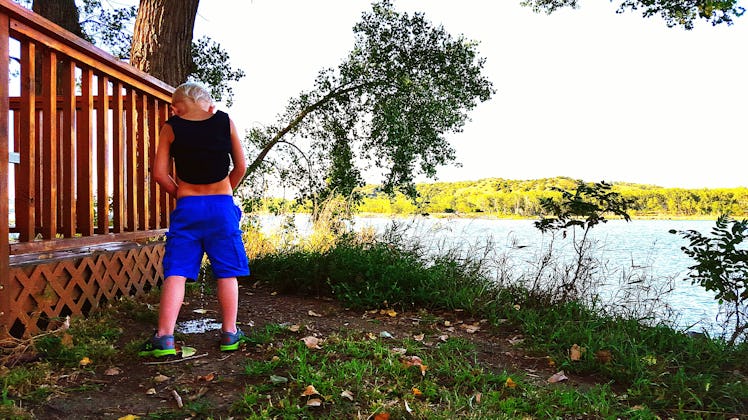How To Teach A Boy To Pee Standing Up (Without the Mess)
A lot of potty training is the same between boys and girls, but boys have to learn to aim. Indoors, that’s messy — outdoors, it’s great fun.

For all parents, potty training is about keeping cool while teaching kids to recognize urgency, control their muscles, and make decisions about when to go to the toilet. Also, patience and gag reflex suppression. But parents potty training boys face a unique issue: Unlike potty training girls, boys have the ability to aim. They also have the ability to miss. So how do you teach a boy to pee standing up?
“Most boys start by sitting down because it’s easier to control their urinary stream than when standing,” says Howard J. Bennett, M.D., and author of The Fantastic Body: What Makes You Tick & How You Get Sick. “That being said, if a boy feels strongly about standing up (like his dad), that’s fine as well.”
An engaged kid whose enthusiasm for potty training outstrips his aim isn’t the worst thing for parents to deal with. Heck, it isn’t the worst thing parents have to clean up. Still, it can be tedious having to clean up the “drop zone” around the toilet bowl each time the kid goes, particularly in uncircumcised boys.
“The urinary stream is less predictable with uncircumcised boys, but in both cases, we ask them to stand close to the toilet or potty and to hold the far end of their penis when they pee,” says Bennett. “This takes a lot of practice, of course.”
Practice is indeed the solution. Bennett recommends a technique for use in the temperate seasons that helps boys understand aiming while making toilet training fun. It’s basically running a home toilet-training boot camp. That sounds more intense than it is — from the kid’s point of view, it’s a game.
“You start by going to the store together and buying some salty snacks and a bag of candy, something the child likes,” advises Bennett. “Then you go outside with the snacks and the potty, just you and the kid. Tell your son there is a potty game that’s lots of fun, and then have him take off everything except his shirt and shoes.”
Parents should make sure the candy — which will be the prize of the game — is out of reach but still visible to the kid. Older siblings shouldn’t be out in the yard during the game — this is just a game for the burgeoning toilet user. The beauty of this technique is that when the little boy inevitably misses the toilet, it isn’t any big deal. It’s just a little wee in the grass.
“The child doesn’t realize that by having them drink more, they’re going to pee more, but you get them to drink by giving them the salty snacks,” says Bennett. “And if he feels like peeing on the potty, he can, and then he gets his treat. If he doesn’t make it to the potty, he gets a pat on the back for trying, but he needs to make it to the potty to get the candy.”
This isn’t a particularly demanding routine — it only goes on for a half hour or so, 60 minutes tops. If the kid loses interest, the game is over. Everybody goes back inside. The toilet is put back where it belongs. The candy is perhaps left in a visible but inaccessible place.
“Tell your child you can play the game again tomorrow if he wants to, but make the suggestion when he seems receptive. If he balks at any of these steps, don’t push. It needs to be fun or it won’t work,” warns Bennett.
Potty training can continue indoors, with the same reward system: candy and praise. If it’s a miss, it isn’t the end of the world. Misses, messes, accidents — it’s all part of the plan.
Tips for Potty Training Boys
- Shorten the Range: If the aim is an issue, have boys stand close to the potty and hold their penis to control their stream.
- Take the Training Out of the Bathroom: Potty training outside can help make those first shaky pisses a mess-free breeze.
- Targets Acquired: Floating targets encourage peeing in the toilet, but they don’t necessarily improve aim. The more stand-up practice a kid has, the better they’ll get at it, though.
This article was originally published on